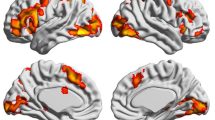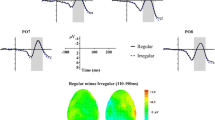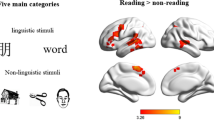Abstract
Chinese is a logographic language system that differs from alphabetic languages, and some of the neurocognitive mechanisms underlying Chinese logographic reading also differ from those underlying alphabetic word reading. However, whether education level effects the neural activation associated with logographic processing of Chinese is still unknown. In the present study, 11 Chinese illiterate and 11 literate (age-matched) subjects participated in an event-related fMRI experiment with Chinese character discrimination (CD) and figure discrimination (FD) tasks. All subjects were asked to view the character or figure pairs and discriminate whether the characters or figures of each stimuli pair were the same or not using response keys. Both literate and illiterate subjects activated a widely distributed cerebral network, including the bilateral inferior, middle and superior frontal gyri, superior temporal gyrus and parietal lobe, in the CD task. Finally, we directly compared the activations of literate subjects with illiterate subjects. The results suggest that the bilateral parts of the angular gyrus and supramarginal gyrus are more active for literate than illiterate subjects in the CD task. We found no significant group difference in the FD task. Therefore, the present results may indicate that education level effects the neural activation associated with the logographic processing of Chinese.





Similar content being viewed by others
References
Abutalebi J, Keim R, Brambati SM, Tettamanti M, Cappa SF, De Bleser R, Perani D (2007) Late acquisition of literacy in a native language. Hum Brain Mapp 28:19–33
Bandettini PA, Cox RW (2000) Event related fMRI contrast when using constant interstimulus interval: theory and experiment. Magn Reson Med 43:540–548
Büchel C, Holmes AP, Rees G, Friston KJ (1998) Characterizing stimulus-response functions using nonlinear regressors in parametric fMRI experiments. Neuroimage 8:140–148
Buchsbaum BR, Olsen RK, Koch PF, Kohn P, Kippenhan JS, Berman KF (2005) Reading, hearing, and the planum temporale. Neuroimage 24:444–454
Burton MW, Locasto PC, Krebs-Noble D, Gullapalli RP (2005) A systematic investigation of the functional neuroanatomy of auditory and visual phonological processing. Neuroimage 26:647–661
Cai C, Kochiyama T, Osaka K, Wu J (2007) Lexical/semantic processing in dorsal left inferior frontal gyrus. NeuroReport 18:1147–1151
Callan DE, Tajima K, Callan AM, Kubo R, Masaki S, Akahane-Yamada R (2003) Learning-induced neural plasticity associated with improved identification performance after training of a difficult second-language phonetic contrast. Neuroimage 19:113–124
Callan DE, Jones JA, Callan AM, Akahane-Yamada R (2004) Phonetic perceptual identification by native- and second-language speakers differentially activates brain regions involved with acoustic phonetic processing and those involved with articulatory-auditory/orosensory internal models. Neuroimage 22:1182–1194
Cao F, Vu M, Lung Chan DH, Lawrence JM, Harris LN, Guan Q, Xu Y, Perfetti CA (2012) Writing affects the brain network of reading in Chinese: a functional magnetic resonance imaging study. Hum Brain Mapp. doi:10.1002/hbm.22017
Carreiras M, Seghier ML, Baquero S, Estévez A, Lozano A, Devlin JT, Price CJ (2009) An anatomical signature for literacy. Nature 461:983–986
Castro-Caldas A (2004) Targeting regions of interest for the study of the illiterate brain. Int J Psychol 39:5–17
Castro-Caldas A, Petersson KM, Reis A, Stone-Elander S, Ingvar M (1998) The illiterate brain. Learning to read and write during childhood influences the functional organization of the adult brain. Brain 121(Pt 6):1053–1063
Chen HC, Juola JF (1982) Dimensions of lexical coding in Chinese and English. Mem Cognit 10:216–224
Cocosco C, Kollokian V, Kwan RS, Evans A, Brainweb (1997) Online interface to a 3D MRI simulated brain database. Neuroimage 5:425
Draganski B, Gaser C, Busch V, Schuierer G, Bogdahn U, May A (2004) Neuroplasticity: changes in grey matter induced by training. Nature 427:311–312
Fiez JA, Balota DA, Raichle ME, Petersen SE (1999) Effects of lexicality, frequency, and spelling-to-sound consistency on the functional anatomy of reading. Neuron 24:205–218
Friedman RF, Ween JE, Albert ML, Alexia., Helman KM, Valenstein E (1993) Clinical neuropsychology, 3rd edn. Oxford University Press, Oxford, pp 37–62
Friston KJ, Fletcher P, Josephs O, Holmes A, Rugg MD, Turner R (1998) Event-related fMRI: characterizing differential responses. Neuroimage 7:30–40
Friston KJ, Penny W, Phillips C, Kiebel S, Hinton G, Ashburner J (2002) Classical and Bayesian inference in neuroimaging: theory. Neuroimage 16:465–483
Funahashi S, Takeda K (2002) Information processes in the primate prefrontal cortex in relation to working memory processes. Rev Neurosci 13:313–345
Golestani N, Zatorre RJ (2004) Learning new sounds of speech: reallocation of neural substrates. Neuroimage 21:494–506
Goodale MA, Milner AD (1992) Separate visual pathways for perception and action. Trends Neurosci 15:20–25
Gottlob LR, Goldinger SD, Stone GO, Van Orden GC (1999) Reading homographs: orthographic, phonologic, and semantic dynamics. J Exp Psychol Hum Percept Perform 25:561
Harpaz Y, Levkovitz Y, Lavidor M (2009) Lexical ambiguity resolution in Wernicke’s area and its right homologue. Cortex 45:1097–1103
Heekeren HR, Marrett S, Ungerleider LG (2008) The neural systems that mediate human perceptual decision making. Nat Rev Neurosci 9:467–479
Hickok G, Poeppel D (2004) Dorsal and ventral streams: a framework for understanding aspects of the functional anatomy of language. Cognition 92:67–99
Indefrey P, Levelt WJM (2000) The neural correlates of language production. In: Gazzaniga M (ed) The new cognitive neurosciences, 2nd edn, pp 845–865
Jung-Beeman M (2005) Bilateral brain processes for comprehending natural language. Trends Cogn Sci 9:512–518
Kochunov P, Fox P, Lancaster J et al (2003) Localized differences in brain morphology between English speaking Caucasian and Chinese speaking Asian populations: new evidence of anatomical plasticity. NeuroReport 23:961–964
Leck KJ, Weekes BS, Chen MJ (1995) Visual and phonological pathways to the lexicon: evidence from Chinese readers. Mem Cognit 23:468–476
Li G, Cheung RT, Gao JH, Lee TM, Tan LH, Fox PT, Jack CR Jr, Yang ES (2006) Cognitive processing in Chinese literate and illiterate subjects: an fMRI study. Hum Brain Mapp 27(2):144–152
Lukatela G, Turvey M (1994) Visual lexical access is initially phonological: 2. Evidence from phonological priming by homophones and pseudohomophones. J Exp Psychol Gen 123:331
Mechelli A, Crinion JT, Noppeney U, O’Doherty J, Ashburner J, Frackowiak RS, Price CJ (2004) Neurolinguistics: structural plasticity in the bilingual brain. Nature 431:757
Mima T, Sadato N, Yazawa S, Hanakawa T, Fukuyama H, Yone-kura Y, Shibasaki H (1999) Brain structures related to active and passive finger movement in man. Brain 22:1989–1997
Newman SD, Twieg D (2001) Differences in auditory processing of words and pseudowords: an fMRI study. Hum Brain Mapp 14:39–47
Novick JM, Trueswell JC, Thompson-Schill SL (2005) Cognitive control and parsing: reexamining the role of Broca’s area in sentence comprehension. Cogn Affect Behav Neurosci 5:263–281
Petersson KM, Reis A, Castro-Caldas A, Ingvar M (1999) Effective auditory-verbal encoding activates the left prefrontal and the medial temporal lobes: a generalization to illiterate subjects. Neuroimage 10:45–54
Petersson KM, Reis A, Askelof S, Castro-Caldas A, Ingvar M (2000) Language processing modulated by literacy: a network analysis of verbal repetition in literate and illiterate subjects. J Cogn Neurosci 12:364–382
Petersson KM, Reis A, Ingvar M (2001) Cognitive processing in literate and illiterate subjects: a review of some recent behavioral and functional neuroimaging data. Scand J Psychol 42:251–267
Petersson KM, Silva C, Castro-Caldas A, Ingvar M, Reis A (2007) Literacy: a cultural influence on functional left-right differences in the inferior parietal cortex. Eur J Neurosci 26:791–799
Price CJ, Wise RJ, Warburton EA et al (1996) Hearing and saying. The functional neuro-anatomy of auditory word processing. Brain 119(Pt 3):919–931
Shen D, Forster KI (1999) Masked phonological priming in reading Chinese words depends on the task. Lang Cogn Process 14:429–459
Snodgrass JG, Vanderwart M (1980) A standardized set of 260 pictures: norms for name agreement, image agreement, familiarity, and visual complexity. J Exp Psychol Hum Learn 6:174–215
Tan LH, Perfetti CA (1998) Phonological codes as early sources of constraint in Chinese word identification: a review of current discoveries and theoretical accounts. Read Writ 10:165–200
Tan LH, Spinks JA, Gao JH et al (2000) Brain activation in the processing of Chinese characters and words: a functional MRI study. Hum Brain Mapp 10:16–27
Tan LH, Liu HL, Perfetti CA, Spinks JA, Fox PT, Gao JH (2001) The neural system underlying Chinese logograph reading. Neuroimage 13:836–846
Tan LH, Spinks JA, Feng CM et al (2003) Neural systems of second language reading are shaped by native language. Hum Brain Mapp 18:158–166
Weiller C, Juptner M, Fellows S et al (1996) Brain representation of active and passive movements. Neuroimage 4:105–110
Wong KFE, Chen HC (1999) Orthographic and phonological processing in reading Chinese text: evidence from eye fixations. Lang Cogn Process 14:461–480
Wu J, Cai C, Kochiyama T, Osaka K (2007) Function segregation in the left inferior frontal gyrus: a listening functional magnetic resonance imaging study. NeuroReport 18:127–131
Xue G, Dong Q, Jin Z, Zhang L, Wang Y (2004) An fMRI study with semantic access in low proficiency second language learners. NeuroReport 15:791–796
Acknowledgments
A portion of this study was supported by a Grant-in-Aid for Scientific Research (B) (21404002, Japan), the AA Science Platform Program of the Japan Society for the Promotion of Science. The authors would like to thank the people who participated in this study and the staff of the Shengyang Shengjing Hospital of the China Medical College for their assistance with data collection.
Author information
Authors and Affiliations
Corresponding authors
Rights and permissions
About this article
Cite this article
Wu, J., Li, X., Yang, J. et al. Prominent activation of the bilateral inferior parietal lobule of literate compared with illiterate subjects during Chinese logographic processing. Exp Brain Res 219, 327–337 (2012). https://doi.org/10.1007/s00221-012-3094-8
Received:
Accepted:
Published:
Issue Date:
DOI: https://doi.org/10.1007/s00221-012-3094-8




